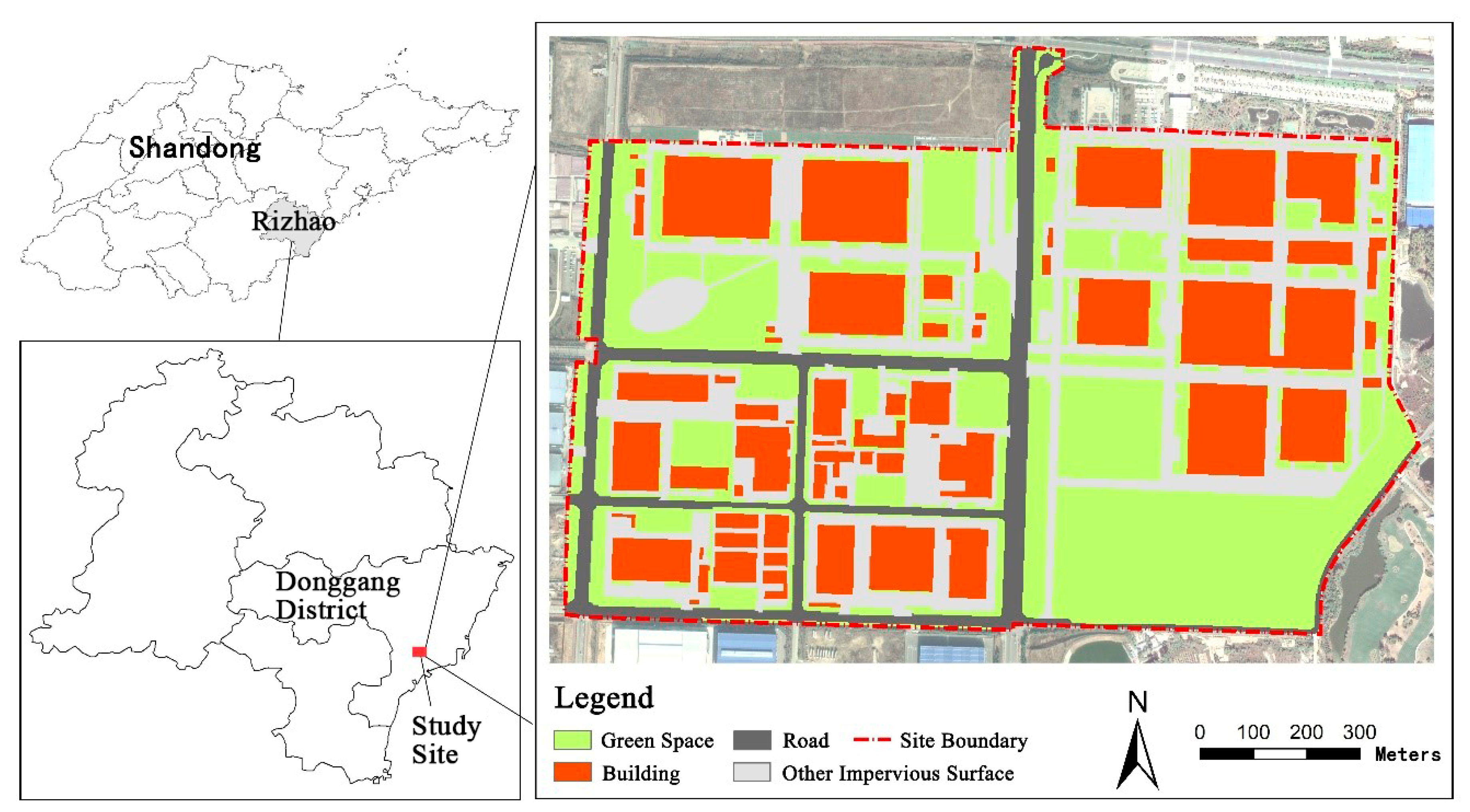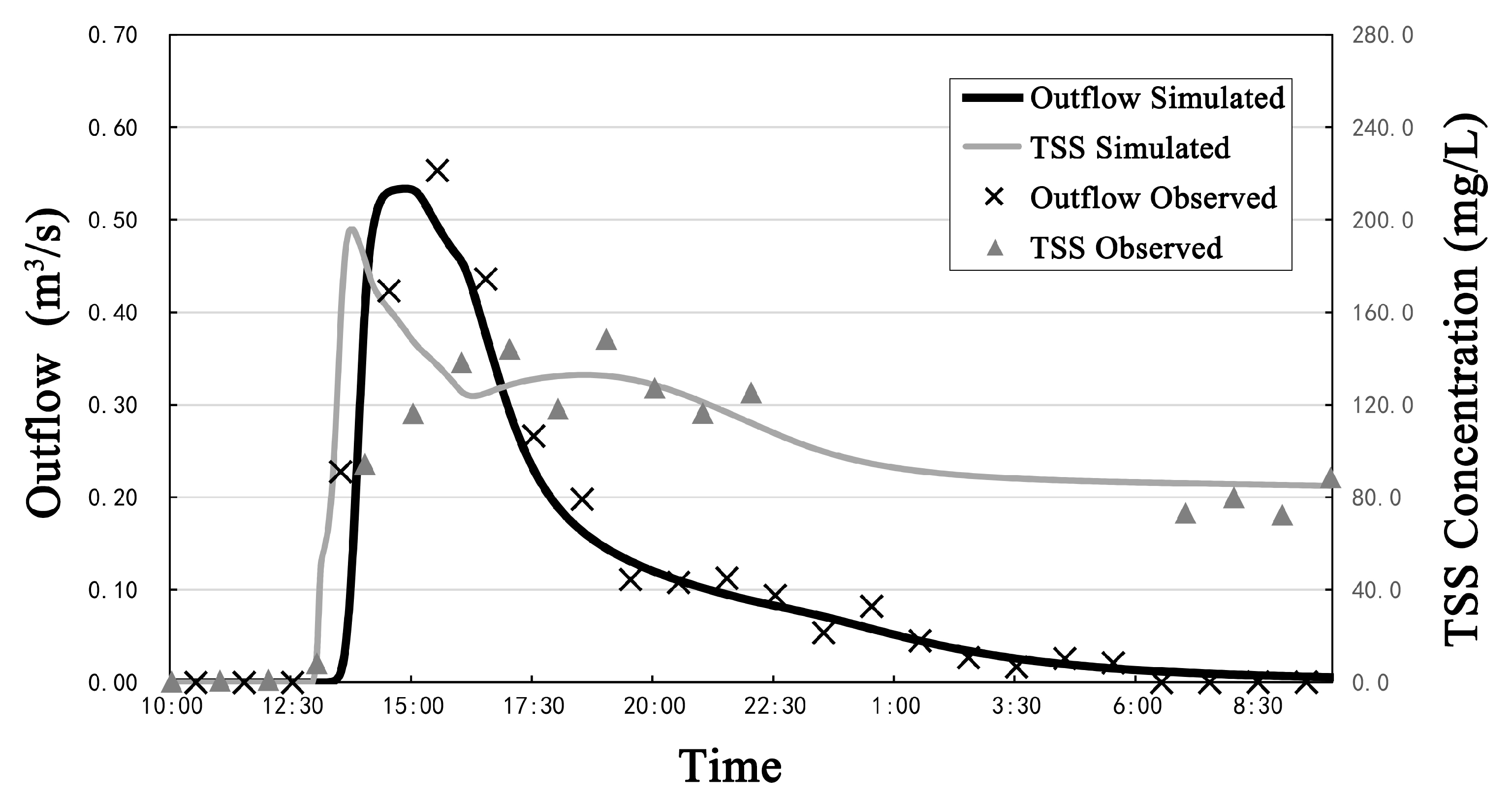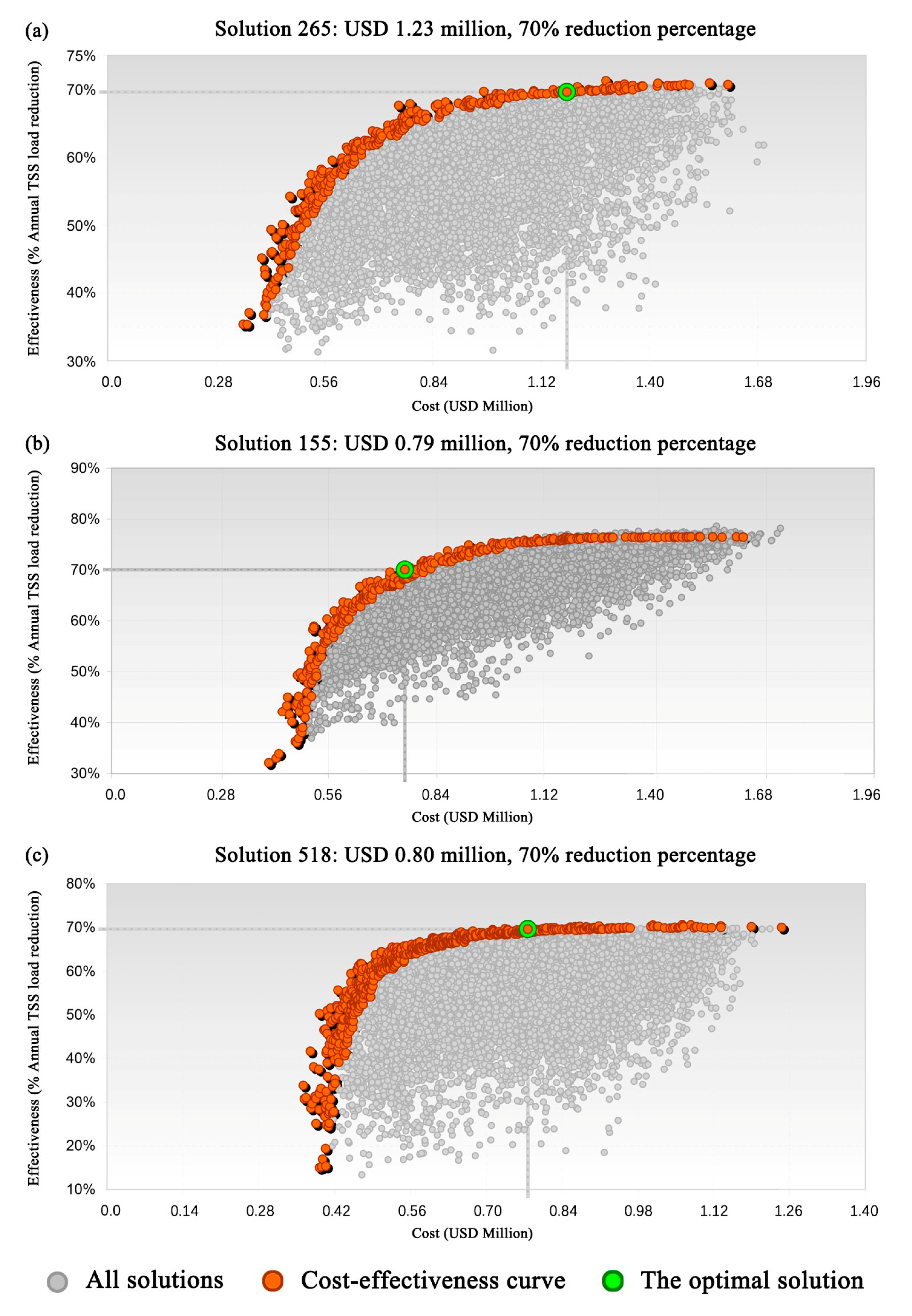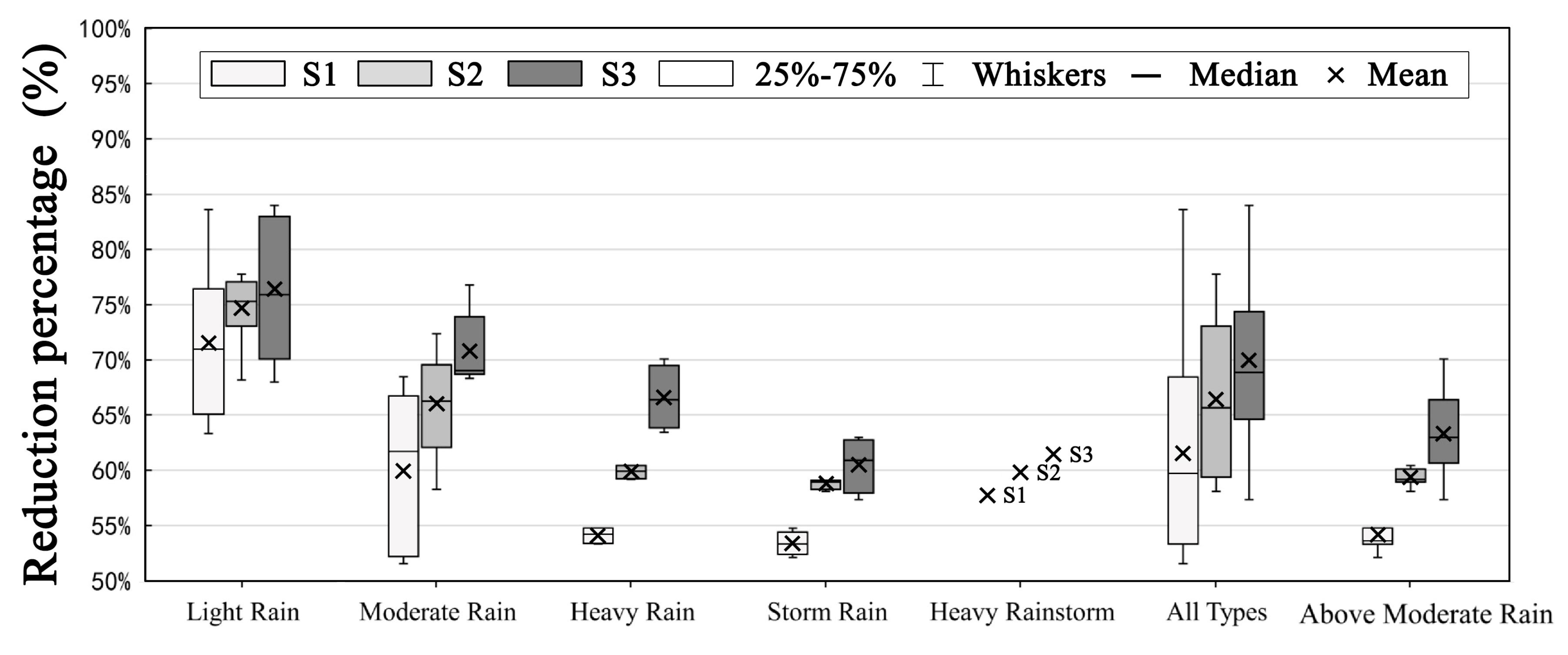Cost-Effectiveness Analysis of Green–Gray Stormwater Control Measures for Non-Point Source Pollution
Abstract
:1. Introduction
2. Materials and Methods
2.1. Study Area and Data Preparation
2.2. Goodness-of-Fit Test
2.3. Siting of Stormwater Control Measures
2.4. Scenario Designs
2.5. Optimization and Cost-Effectiveness Analysis
3. Results
3.1. Parameters Calibration
3.2. SCM Siting and Scenario Designs
3.3. Cost-Effectiveness Analysis
3.4. Effectiveness of Pollution Control Under Different Event Types
4. Discussion
5. Conclusions
Author Contributions
Acknowledgments
Conflicts of Interest
References
- Eckart, K.; McPhee, Z.; Bolisetti, T. Performance and implementation of low impact development—A review. Sci. Total Environ. 2017, 607, 413–432. [Google Scholar] [CrossRef] [PubMed]
- Zhao, H.T.; Zou, C.L.; Zhao, J.; Li, X.Y. Role of Low-Impact Development in generation and control of urban diffuse pollution in a pilot sponge city: A paired-catchment study. Water 2018, 10, 852. [Google Scholar] [CrossRef] [Green Version]
- Jia, H.; Yao, H.; Tang, Y.; Shaw, L.Y.; Field, R.; Tafuri, A.N. LID-BMPs planning for urban runoff control and the case study in China. J. Environ. Manag. 2015, 149, 65–76. [Google Scholar] [CrossRef] [PubMed]
- Wu, X.Y.; Huang, W.; Zhou, M. Low impact development planning and evaluation in an industrial park based on SWMM simulation. China Water Wastewater. 2017, 33, 139–142. [Google Scholar]
- Jia, H.; Wang, Z.; Zhen, X.Y.; Clar, M.; Shaw, L.Y. China’s sponge city construction: A discussion on technical approaches. Front. Environ. Sci. Eng. 2017, 11, 18. [Google Scholar] [CrossRef]
- Che, W.; Zhang, W. Urban Stormwater Management and Sponge City Concept in China. In Urban. Water Management for Future Cities; Springer: Berlin/Heidelberg, Germany, 2019. [Google Scholar]
- Ren, N.; Wang, Q.; Wang, Q.R.; Huang, H.; Wang, X.H. Upgrading to urban water system 3.0 through sponge city construction. Front. Environ. Sci. Eng. 2017, 11, 9. [Google Scholar] [CrossRef]
- Xia, J.; Zhang, Y.Y.; Xiong, L.H.; He, S.; Wang, L.F.; Yu, Z. Opportunities and challenges of the Sponge City construction related to urban water issues in China. Sci. China (Earth Sci.) 2017, 60, 652–658. [Google Scholar] [CrossRef]
- Alves, A.; Gersonius, B.; Sanchez, A.; Vojinovic, Z.; Kapelan, Z. Multi-criteria Approach for Selection of Green and Grey Infrastructure to Reduce Flood Risk and Increase CO-benefits. Water Resour. Manag. 2018, 32, 2505–2522. [Google Scholar] [CrossRef]
- Nguyen, T.T.; Ngo, H.H.; Guo, W.S.; Wang, X.C.; Ren, N.Q.; Li, G.B.; Ding, J.; Liang, H. Implementation of a specific urban water management—Sponge City. Sci. Total Environ. 2019, 652, 147–162. [Google Scholar] [CrossRef]
- Alves, A.; Sanchez, A.; Vojinovic, Z.; Seyoum, S.; Babel, M.; Brdjanovic, D. Evolutionary and holistic assessment of green-grey infrastructure for CSO reduction. Water 2016, 8, 402. [Google Scholar] [CrossRef]
- Bakhshipour, A.E.; Dittmer, U.; Haghighi, A.; Nowak, W. Hybrid green-blue-gray decentralized urban drainage systems design, a simulation-optimization framework. J. Environ. Manag. 2019, 249, 109364. [Google Scholar] [CrossRef] [PubMed]
- Xu, C.; Tang, T.; Jia, H.F.; Xu, M.; Xu, T.; Liu, Z.J.; Long, Y.; Zhang, R.R. Benefits of coupled green and grey infrastructure systems: Evidence based on analytic hierarchy process and life cycle costing. Resour. Conserv. Recycl. 2019, 151, 104478. [Google Scholar] [CrossRef]
- Zhang, Z.; Gu, J.J.; Zhang, G.S.; Ning, P.; Ma, W.J.; Zhao, L.; Shen, J. Hybrid Stormwater Management Approaches in a High-Plateau Watershed in Southwest China. In Proceedings of the IOP Conference Series: Earth and Environmental Science, Xi’an, China, 15–16 December 2018. [Google Scholar]
- Liao, Z.; Chen, H.; Huang, F.; Li, H.Z. Cost–effectiveness analysis on LID measures of a highly urbanized area. Desalin. Water Treat. 2015, 56, 2817–2823. [Google Scholar] [CrossRef]
- Xu, T.; Jia, H.F.; Wang, Z.; Mao, X.H.; Xu, C.Q. SWMM-based methodology for block-scale LID-BMPs planning based on site-scale multi-objective optimization: A case study in Tianjin. Front. Environ. Sci. Eng. 2017, 11, 1. [Google Scholar] [CrossRef]
- Mei, C.; Liu, J.H.; Wang, H.; Yang, Z.Y.; Ding, X.Y.; Shao, W.W. Integrated assessments of green infrastructure for flood mitigation to support robust decision-making for sponge city construction in an urbanized watershed. Sci. Total Environ. 2018, 639, 1394–1407. [Google Scholar] [CrossRef]
- Fan, X.Z.; Matsumoto, T. GIS-Based Social Cost–Benefit Analysis on Integrated Urban Water Management in China: A Case Study of Sponge City in Harbin. Sustainability 2019, 11, 5527. [Google Scholar] [CrossRef] [Green Version]
- Liu, Q.; Zhou, Y.R. Scatter search for multi-objective optimization problem. Comput. Eng. Appl. 2006, 44, 66–68. [Google Scholar]
- Steinbrunn, M.; Moerkotte, G.; Kemper, A. Heuristic and randomized optimization for the join ordering problem. VLDB J. 1997, 6, 191–208. [Google Scholar] [CrossRef]
- Mao, X.H.; Jia, H.F.; Shaw, L.Y. Assessing the ecological benefits of aggregate LID-BMPs through modelling. Ecol. Model. 2017, 353, 139–149. [Google Scholar] [CrossRef]
- Liang, C.Y.; You, G.J.Y.; Lee, H.Y. Investigating the effectiveness and optimal spatial arrangement of low-impact development facilities. J. Hydrol. 2019, 577, 124008. [Google Scholar] [CrossRef]
- Gao, J.; Wang, R.S.; Huang, J.L.; Liu, M. Application of BMP to urban runoff control using SUSTAIN model: Case study in an industrial area. Ecol. Model. 2015, 318, 177–183. [Google Scholar] [CrossRef]
- Li, C.; Liu, M.; Hu, Y.M.; Han, R.Q.; Shi, T.; Qu, X.Q.; Wu, Y.L. Evaluating the hydrologic performance of low impact development scenarios in a micro urban catchment. Int. J. Environ. Res. Public Health. 2018, 15, 273. [Google Scholar] [CrossRef] [PubMed] [Green Version]
- You, L.D.; Xu, T.; Mao, X.H.; Jia, H.F. Site-scale LID-BMPs planning and optimization in residential areas. J. Sustain. Water Built Environ. 2018, 5, 05018004. [Google Scholar] [CrossRef]
- Nash, J.E.; Sutcliffe, J.V. River flow forecasting through conceptual models part I—A discussion of principles. J. Hydrol. 1970, 10, 282–290. [Google Scholar] [CrossRef]
- Peng, H.Q.; Liu, Y.; Wang, H.W.; Ma, L.M. Assessment of the service performance of drainage system and transformation of pipeline network based on urban combined sewer system model. Environ. Sci. Pollut. Res. 2015, 22, 15712–15721. [Google Scholar] [CrossRef]
- Bell, C.D.; Spahr, K.; Grubert, E.; Stokes-Draut, J.; Gallo, E.; McCray, J.E.; Hogue, T.S. Decision making on the gray-green stormwater infrastructure continuum. J. Sustain. Water Built Environ. 2018, 05, 4018016. [Google Scholar] [CrossRef]
- Ahiablame, L.M.; Engel, B.A.; Chaubey, I. Effectiveness of low impact development practices: Literature review and suggestions for future research. Water Air Soil Pollut. 2012, 223, 4253–4273. [Google Scholar] [CrossRef]
- Liu, W.; Chen, W.P.; Peng, C. Assessing the effectiveness of green infrastructures on urban flooding reduction: A community scale study. Ecol. Model. 2014, 291, 6–14. [Google Scholar] [CrossRef]
- Liu, Y.Z.; Engel, B.A.; Flanagan, D.C.; Gitau, M.W.; McMillan, S.K.; Chaubey, I. A review on effectiveness of best management practices in improving hydrology and water quality: Needs and opportunities. Sci. Total Environ. 2017, 601–602, 580–593. [Google Scholar] [CrossRef]
- Li, C.H.; Peng, C.; Chiang, P.C.; Cai, Y.P.; Wang, X.; Yang, Z.F. Mechanisms and applications of green infrastructure practices for stormwater control: A review. J. Hydrol. 2019, 568, 626–637. [Google Scholar] [CrossRef]
- Technical Guide for the Construction of the Sponge City. Available online: http://www.mohurd.gov.cn/wjfb/201411/W020141102041225.pdf (accessed on 18 January 2019).
- International Stormwater BMP Database. Available online: www.bmpdatabase.org (accessed on 22 October 2019).
- Tian, Y.J.; Li, T.; He, S.M.; Zhong, A.C.; Dong, L.Y. Characteristics of non-point pollution of Fengqiao Industrial Park in Suzhou. China Water Wastewater 2009, 25, 89–91. [Google Scholar]
- Wang, Y.X.; Yang, X.L.; Hu, R.H.; Huang, W. Analysis of rainfall-runoff pollution load of Hutang Textile Industrial Park in Changzhou City. Water Res. Prot. 2017, 33, 68–73. [Google Scholar] [CrossRef] [PubMed] [Green Version]
- United States. Environmental Protection Agency; Water Planning Division. Results of the Nationwide Urban. Runoff Program; Water Planning Division: Washington, DC, USA, 1982.
- Classification Criteria for Precipitation Intensity. Available online: http://www.gov.cn/ztzl/2008tffy/content_1113935.htm (accessed on 30 November 2019).
- Venkataramanan, V.; Packman, A.I.; Peters, D.R.; Lopez, D.; McCuskey, D.J.; McDonald, R.I.; Miller, M.M.; Young, S.L. A systematic review of the human health and social well-being outcomes of green infrastructure for stormwater and flood management. J. Environ. Manag. 2019, 246, 868–880. [Google Scholar] [CrossRef] [PubMed]
- Zhang, K.; Chui, T.F.M. Linking hydrological and bioecological benefits of green infrastructures across spatial scales—A literature review. Sci. Total Environ. 2019, 646, 1219–1231. [Google Scholar] [CrossRef] [PubMed]







| Land Use Type | Green Space | Building | Road | Other Impervious Surface |
|---|---|---|---|---|
| Area (ha) | 51.46 | 39.47 | 35.90 | 12.07 |
| Percentage (%) | 37.05 | 28.42 | 25.84 | 8.69 |
| SCMs | Structural Parameters | Soil Parameters | Cost (USD) | |||||
|---|---|---|---|---|---|---|---|---|
| Length (m) | Width (m) | Height (m) | Surface Storage (m) | Bottom Storage (m) | Depth (m) | Void Ratio | ||
| IT 1 | Depends on location | 1.8 | -- | 0.15 | -- | 0.2 | 0.6 | 38.15/m3 |
| PP 2 | Depends on location | 5 | -- | -- | -- | 0.24 | -- | 28.84/m2 |
| CS 3 | 6 | -- | 4.8 | -- | -- | -- | -- | 55.80/m2 |
| GR 4 | Depends on location | -- | -- | -- | 0.3 | 0.4 | 46.5/m2 | |
| BC 5 | Depends on location | -- | 0.2 | 0.3 | 1 | 0.6 | 121.38/m2 | |
| VFS 6 | Depends on location | 10 | Side Slope | Surface Slope | Roughness | 0.2 | 0.6 | 65.98/m2 |
| 1:3 | 4% | 0.2 | ||||||
| Parameter | Input Value | Parameter | Input Value |
|---|---|---|---|
| N-Imperv 1 | 0.005 | Max.Infil.Rate 4 (mm/h) | 76.2 |
| N-Perv 2 | 0.15 | Min.Infil.Rate 5 (mm/h) | 10.16 |
| Conduits’ Manning’s N | 0.04 | Decay Constant | 5 |
| DStore-Imperv 3 (mm) | 0.1 | DStore-Perv 6 (mm) | 2.54 |
| Land Use Type | Buildup Parameters | Wash-off Parameters | ||
|---|---|---|---|---|
| Building | Max. Buildup (kg/ha) | 123.8 | Coefficient | 0.007 |
| Rate Constant (d) | 0.31 | Exponent | 1.8 | |
| Green Space | Max. Buildup (kg/ha) | 105.6 | Coefficient | 0.004 |
| Rate Constant (d) | 0.9 | Exponent | 1.2 | |
| Road/Other Impervious Surface | Max. Buildup (kg/ha) | 114.66 | Coefficient | 0.008 |
| Rate Constant (d) | 1.02 | Exponent | 1.8 | |
| SCMs | IT | PP | CS | GR | BC | VFS | Total |
|---|---|---|---|---|---|---|---|
| Area (ha) | 4.62 | 4.45 | 2.61 | 1.16 | 5.34 | 4.04 | 16.14 |
| Proportion (%) | 3.33 | 3.21 | 1.88 | 0.84 | 3.85 | 2.91 | 16.02 |
| Scenarios | SCMs | Cost Proportion (%) | Total Cost (USD Million) | Total Area (ha) |
|---|---|---|---|---|
| S1 | BC | 52 | 0.64 | 0.53 |
| GR | 1 | 0.01 | 0.03 | |
| VFS | 47 | 0.58 | 0.87 | |
| Total | 100 | 1.23 | 1.43 | |
| S2 | CS | 6 | 0.05 | 0.06 |
| PP | 60 | 0.48 | 1.65 | |
| IT | 34 | 0.26 | 3.53 | |
| Total | 100 | 0.79 | 5.24 | |
| S3 | CS | 27 | 0.22 | 0.12 |
| BC | 20 | 0.16 | 0.13 | |
| PP | 6 | 0.05 | 0.17 | |
| GR | 3 | 0.02 | 0.05 | |
| VFS | 23 | 0.18 | 0.28 | |
| IT | 21 | 0.17 | 2.19 | |
| Total | 100 | 0.80 | 2.94 |
© 2020 by the authors. Licensee MDPI, Basel, Switzerland. This article is an open access article distributed under the terms and conditions of the Creative Commons Attribution (CC BY) license (http://creativecommons.org/licenses/by/4.0/).
Share and Cite
Qiu, S.; Yin, H.; Deng, J.; Li, M. Cost-Effectiveness Analysis of Green–Gray Stormwater Control Measures for Non-Point Source Pollution. Int. J. Environ. Res. Public Health 2020, 17, 998. https://0-doi-org.brum.beds.ac.uk/10.3390/ijerph17030998
Qiu S, Yin H, Deng J, Li M. Cost-Effectiveness Analysis of Green–Gray Stormwater Control Measures for Non-Point Source Pollution. International Journal of Environmental Research and Public Health. 2020; 17(3):998. https://0-doi-org.brum.beds.ac.uk/10.3390/ijerph17030998
Chicago/Turabian StyleQiu, Shi, Haiwei Yin, Jinling Deng, and Muhan Li. 2020. "Cost-Effectiveness Analysis of Green–Gray Stormwater Control Measures for Non-Point Source Pollution" International Journal of Environmental Research and Public Health 17, no. 3: 998. https://0-doi-org.brum.beds.ac.uk/10.3390/ijerph17030998




